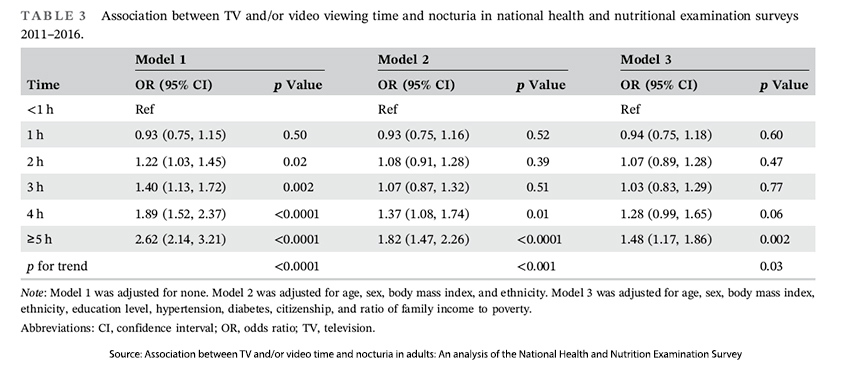Nocturia refers to getting up at night to urinate. Depending upon the frequency, it can be a nuisance or disability, but it remains preferable to not getting up at all when you have to urinate. Watching screens, especially television or video, has also been associated with “unhealthy lifestyle choices,” in the words of the researchers, escalating the risk of obesity and diabetes-established risk factors for nocturia. Is there an association between the two?
The researchers turned to our National Health and Nutrition Examination Survey (NHANES) between 2011 and 2016 to resolve this question. In addition to the usual demographic information, they honed in on the self-reported number of hours spent per day “sitting and watching TV or videos” and the equally self-reported number of times in the last 30 days you “most typically get up to urinate.”
TV watching was categorized in hourly increments. Anyone with 2 or more trips to the bathroom at night was classified as having nocturia.
“Individuals in the group with the longest TV or video viewing time had a significantly 48% higher risk of experiencing nocturia in comparison to the group with the shortest TV or video viewing time.”
This group included:
- Women
- Older individuals
- US citizens, as opposed to non-citizens
- Non-Hispanic Blacks
- Individuals who had not graduated from high school
- Higher BMI
- Lower socioeconomic status as measured by what the researchers termed the RIP, the ratio of income to poverty level
- Individuals with hypertension and diabetes
Even to the untrained eye, it would be a Herculean effort to identify a common underlying cause across all these groups. This did not prevent them from trying. Among their concerns
Extended TV viewing heightens “the likelihood of developing type 2 diabetes.” For those concerned, the cited study calculates that your risk increases by 20% for “every 2-hour increase in TV viewing per day.”
“TV watching typically aligns with beverage consumption, leading to an elevated fluid intake.” Unfortunately, in this study, alterations in biomarkers were only seen with TV screens; computer screens were magically protective. And there was no mention of elevated fluid anywhere in the study – so much for peer review.
“…findings suggested that prolonged TV viewing may lead to neurological disorders, which could potentially trigger bladder dysfunction.”
Again, this additional study does not mention neurological disorders, but maybe it was mentioned in private communication rather than sloppy review.
Finally, it wouldn’t be a health study if we didn’t consider the possibility of increasing systemic inflammation from high-intensity TV viewing. For the curious, high-intensity TV is more than 3 hours a day, and to qualify for this study, you need to be pregnant. Apply grains of salt as you desire.
The models generated by the study are presented here.

The fully adjusted model, presumably only for TV watching, is model 3. As a public service, I would point out that 3-hours of uninterrupted TV seems pivotal. It is only in that fourth hour that nocturia appears to be more common. Perhaps it is an opportunity to get up, move those legs, and what the heck, urinate.
Source: Association between TV and/or video time and nocturia in adults: An analysis of the National Health and Nutrition Examination Survey Neurourology Urodynamics DOI: 10.1002/nau.25406




